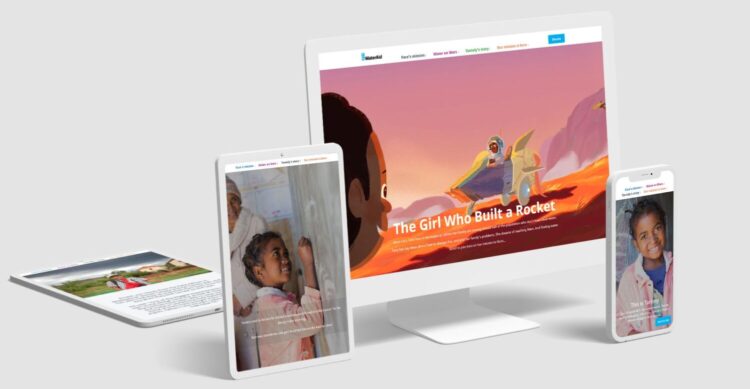In the digital age, where attention spans are short and competition is fierce, having a website that captures and retains visitor interest is crucial for any business. Visual storytelling has emerged as a powerful tool in transforming mundane websites into engaging platforms, attracting new leads and fostering brand loyalty.
This article delves into the nuances of visual storytelling, offering insights and strategies for businesses looking to revamp their online presence.
Understanding Visual Storytelling
Visual storytelling, a vital aspect for any freelance website designer, combines the art of narrating a compelling story with the power of captivating visuals. It goes beyond merely inserting images alongside text; it revolves around crafting a narrative that truly connects with the audience while leveraging visuals to strengthen and enhance the message.
This strategy harnesses humanity’s innate fondness for stories and the brain’s natural inclination to process visual content more efficiently than plain text.

The Impact on Website Engagement
Websites employing visual storytelling see a significant boost in user engagement. Visitors are more likely to spend time on a site that tells a compelling story through visuals, as these elements make the content more digestible and memorable.
This increased engagement not only improves user experience but also contributes positively to search engine rankings, as search engines favor websites with higher user engagement.
Crafting a Visual Narrative
Creating a visual narrative involves more than selecting attractive images. It requires a deep understanding of your brand’s story and the message you want to convey. The narrative should align with your brand’s values and goals, and the visuals should reflect the tone and emotion of your story.
Consistency in style and color schemes across all visuals also helps in creating a cohesive and immersive experience.

Choosing the Right Visuals
The choice of visuals is critical in visual storytelling. High-quality images, infographics, videos, and animations can all be part of the narrative. Each visual should serve a purpose, whether it’s to evoke an emotion, explain a concept, or illustrate a point. Custom visuals are particularly effective as they can be tailored to fit your story perfectly.
Integrating Text and Visuals
While visuals are at the heart of visual storytelling, text still plays a vital role. The key is to strike the right balance between text and visuals, ensuring they complement each other. Text should provide context to the visuals, while the visuals should add depth to the text. This harmony between text and visuals makes the content more engaging and easier to understand.
Leveraging Technology
Advancements in technology have opened up new possibilities in visual storytelling. Interactive elements like hover effects, scrolling animations, and virtual reality can add a dynamic layer to your story, making it more immersive. These technologies not only captivate visitors but also encourage them to interact with your content, enhancing their overall experience.
Optimizing for Different Platforms
In today’s multi-device world, ensuring your visual story is optimized for different platforms is essential. Responsive design ensures that your visuals and layout adjust seamlessly to different screen sizes, providing a consistent experience across desktops, tablets, and smartphones.

Measuring Success
To understand the impact of visual storytelling on your website, it’s important to track key metrics such as page views, time spent on the site, and conversion rates. Analyzing these metrics will provide insights into what works and what doesn’t, allowing you to refine your strategy.
Enhancing Brand Identity through Visual Storytelling
Visual storytelling plays a pivotal role in reinforcing a brand’s identity. The visuals used on a website should reflect the brand’s personality, whether it’s professional, playful, innovative, or compassionate.
This consistency in visual language helps in building a strong brand image in the minds of the audience. It’s not just about showing products or services, but about narrating the brand’s journey, its values, and its vision, thereby creating a deeper connection with the audience.
Emotional Connection and Customer Loyalty
One of the most profound effects of visual storytelling is its ability to forge an emotional connection with the audience. By telling stories that resonate on an emotional level, businesses can transcend the traditional buyer-seller relationship, fostering a sense of loyalty and trust among their audience.
This emotional engagement is key in converting first-time visitors into repeat customers and brand advocates.
Incorporating User-Generated Content
User-generated content (UGC) can be a valuable component of visual storytelling. Featuring images, videos, or stories from customers not only provides authentic content but also encourages more audience engagement.
It shows that the brand values its customers’ experiences and is confident enough to showcase them. UGC can make the storytelling more relatable and trustworthy, further enhancing the appeal of the website.

Staying Ahead of Trends
The digital landscape is constantly evolving, and so are the trends in visual storytelling. Keeping abreast of the latest trends, such as augmented reality, 3D visuals, or interactive storytelling, can give a competitive edge. However, it’s important to integrate these trends in a way that aligns with your brand story and adds value to your audience, rather than using them just for the sake of being trendy.
Accessibility and Inclusivity in Visual Storytelling
Accessibility should be a key consideration in visual storytelling. Ensuring that your website’s visuals and interactive elements are accessible to all, including those with disabilities, is not only a legal requirement in many regions but also a moral imperative. Moreover, inclusive storytelling that reflects the diversity of your audience can broaden your reach and appeal.
The Role of Analytics in Refining Your Story
Finally, leveraging analytics is crucial in refining your visual storytelling approach. Understanding how users interact with your visual content can provide insights into their preferences and behaviors. This data-driven approach allows for continuous improvement and adaptation of your visual storytelling strategy, ensuring that it remains effective and relevant.
Final Thoughts
In conclusion, visual storytelling is a dynamic and powerful strategy to transform boring websites into captivating platforms that win new leads. By understanding your audience, crafting a compelling narrative, choosing the right visuals, and leveraging the latest technologies, you can create an engaging and memorable online experience.
It’s an ongoing process that requires creativity, adaptability, and a commitment to telling your brand’s story in a way that resonates with and captivates your audience. With the right approach, visual storytelling can be the key to unlocking the full potential of your digital presence.
 Hi Boox Popular Magazine 2024
Hi Boox Popular Magazine 2024



